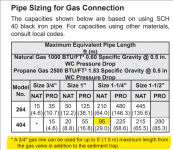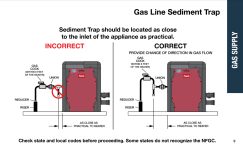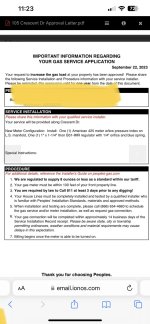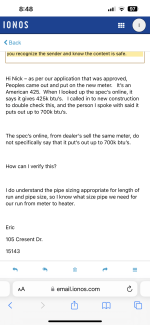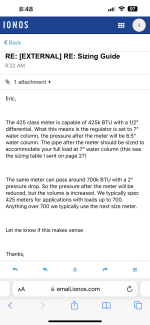What should I say to the gas co. tomorrow morning when I call regarding the output of the 425 meter - they told me it puts out 700k btu?
Heater issue?
- Thread starter Sendit6
- Start date
You are using an out of date browser. It may not display this or other websites correctly.
You should upgrade or use an alternative browser.
You should upgrade or use an alternative browser.
Ask them to explain the discrepancy between the meter label and their claim of 700 CFH.What should I say to the gas co. tomorrow morning when I call regarding the output of the 425 meter - they told me it puts out 700k btu?
If they know what they're talking about, then they can tell you exactly where they got that rating.
If they cannot tell you exactly how they got that rating, then you need to tell them to figure it out and get back to you with a real explanation.
And what would be my retort if they say something like, the meter will push out 700k btu if we up the pressure. Or some other explanation that tries to justify the 425.
This is what I would say:And what would be my retort if they say something like, the meter will push out 700k btu if we up the pressure.
"Please explain where you are getting these figures".
They have to be getting the information from somewhere.
Either they are just making things up and pulling imaginary data from thin air or they have a reference that tells them what they are saying.
If they have a reference, tell them to give it to you.
As it shows in the manufacturer's document, the rating at a 2" w.c pressure differential is 898 SCFH.
This rating might be acceptable if they increase the inlet pressure to the meter.
Typical inlet is 6.92" (0.25 psi) to 7.5" w.c. (0.271 psi) up to 0.5 psi (13.8 in WC).
The heater specifies a maximum pressure of 10.5" w.c, so the pressure should not exceed that.
Maybe if the meter inlet pressure is 9" w.c to 10.5" w.c, the meter will perform properly.
This will allow a 7" w.c to 8.5 dynamic at the output of the meter and about 6" to 7.5" at the inlet to the gas valve (dynamic), which is in spec.


This rating might be acceptable if they increase the inlet pressure to the meter.
Typical inlet is 6.92" (0.25 psi) to 7.5" w.c. (0.271 psi) up to 0.5 psi (13.8 in WC).
The heater specifies a maximum pressure of 10.5" w.c, so the pressure should not exceed that.
Maybe if the meter inlet pressure is 9" w.c to 10.5" w.c, the meter will perform properly.
This will allow a 7" w.c to 8.5 dynamic at the output of the meter and about 6" to 7.5" at the inlet to the gas valve (dynamic), which is in spec.
The meter says 7.5-11 wc.
So what you said above would work if they increase the pressure?
So what you said above would work if they increase the pressure?
Probably.The meter says 7.5-11 wc.
So what you said above would work if they increase the pressure?
In my opinion, the meter is probably undersized.
In any case, I would verify the gas pressure under full load to see how much pressure drop you have.
A general questuon:
It looks like the pipe that connects to the heater, the last 2’3’ coming from the 1 1/4”, is smaller, like 1” or maybe even 3/4”?
Is the case with all of the last bit of pipe that connects to heaters, it gets smaller where it connects to the heater, no matter how big it is before that last bit?
It looks like the pipe that connects to the heater, the last 2’3’ coming from the 1 1/4”, is smaller, like 1” or maybe even 3/4”?
Is the case with all of the last bit of pipe that connects to heaters, it gets smaller where it connects to the heater, no matter how big it is before that last bit?
Just spoke with gas co., their department that handles new gas and additional gas service, the department that I had to apply for to ad service.
The tech said yes that is the correct meter, and it supplies 351-700k btu.
The 425 listed online is the model number. I asked where on People’s Gas website does it say that the meter gives up to 700k. She said it’s the correct meter for what I applied for.
Unless I ores and ask to speak to an actual engineer who approves the applications for more gas, I may not be able to find out.
Seems like the only way I can find out is to run the correct size pipe and see what happens.
As I said, the tech that came to put this new meter on said, at the time, that they’d be able to
“Up the pressure”.
The tech said yes that is the correct meter, and it supplies 351-700k btu.
The 425 listed online is the model number. I asked where on People’s Gas website does it say that the meter gives up to 700k. She said it’s the correct meter for what I applied for.
Unless I ores and ask to speak to an actual engineer who approves the applications for more gas, I may not be able to find out.
Seems like the only way I can find out is to run the correct size pipe and see what happens.
As I said, the tech that came to put this new meter on said, at the time, that they’d be able to
“Up the pressure”.
The concern that I have with the idea that the gas supplier can “Increase the Pressure if necessary” is how do you know if it is necessary?
Is someone going to monitor the gas pressure to make sure that it remains good?
Most likely, the pressure will be ok if the pressure is set to about 9” w.c to 10” w.c.
Here are some contacts that should be able to provide some information.
IMAC Systems, Inc.
90 Main Street, PO Box 1605. Tullytown, PA 19007
1-800-955-4GAS
Phone: (215) 946-2200
[email protected]
[email protected]
Is someone going to monitor the gas pressure to make sure that it remains good?
Most likely, the pressure will be ok if the pressure is set to about 9” w.c to 10” w.c.
Here are some contacts that should be able to provide some information.
IMAC Systems, Inc.
90 Main Street, PO Box 1605. Tullytown, PA 19007
1-800-955-4GAS
Phone: (215) 946-2200
IMAC Systems, Inc.
Solutions for Gas Measurement, Pressure control and Catalytic Heating. Gas meters & repair, rotary, diaphragm, and turbine meters, schlumberger gas pressure regulators, repair and calibration of American Meter, Dressure Roots, Romet, Equimeter, Invensys, Elster Turbine, stocking distributors.
www.imacsystems.com
[email protected]
[email protected]
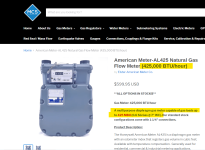
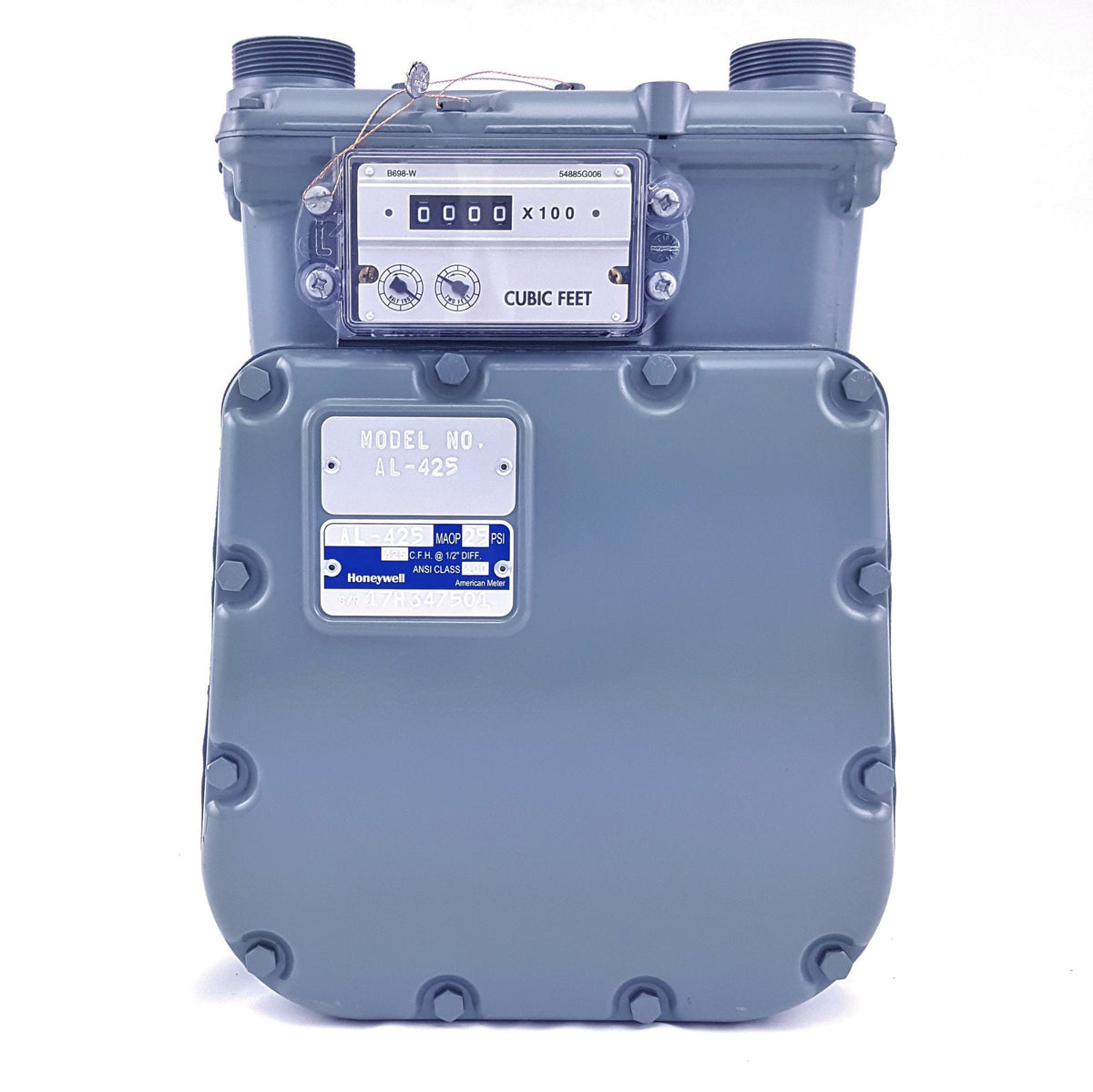
American Meter-AL425 Natural Gas Flow Meter (425,000 BTU/hour)
**ALL OPTIONS IN STOCK!!!** Gas Meter: 425,000 BTU/hour A multipurpose diaphragm gas meter capable of gas loads up to 425 MBH (0.6 SG Gas @ 7" WC). Our standard stock configurations come with 1-1/4" connections. Product Description: The Honeywell American Meter AL425 is a diaphragm gas meter...
 mcsmeters.com
mcsmeters.com
66 + 75 + 400 = 541 cubic feet per hour minimum gas meter size.
If we allow for a 1" w.c pressure differential, the meter is rated for up to 583 CFH.
Most likely, the meter will be fine if the line is sized correctly at 1.5".
If the pressure is 7" and we allow for a 1" drop through the meter and a 1" drop through the gas line, then the dynamic gas pressure at the heater gas valve inlet should be at least 5" w.c.
In my opinion, that is a little bit low, but it is still within the manufacturer's specifications.
In any case, I would verify the gas pressure under full load to make sure that it is correct from time of install.
I would want and expect the installer to do a full and proper commissioning of the heater as it is placed into service.
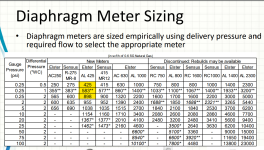
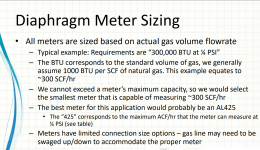
If we allow for a 1" w.c pressure differential, the meter is rated for up to 583 CFH.
Most likely, the meter will be fine if the line is sized correctly at 1.5".
If the pressure is 7" and we allow for a 1" drop through the meter and a 1" drop through the gas line, then the dynamic gas pressure at the heater gas valve inlet should be at least 5" w.c.
In my opinion, that is a little bit low, but it is still within the manufacturer's specifications.
In any case, I would verify the gas pressure under full load to make sure that it is correct from time of install.
I would want and expect the installer to do a full and proper commissioning of the heater as it is placed into service.


Attachments
I still want to know what their proof is that it will deliver up to 700k btu.
i called again, I think I talked to the same person , and she said they supplied the gas meter that would carry the load that I put on the application.
, and she said they supplied the gas meter that would carry the load that I put on the application.
Which is is 400, 66, and 75 k btu.
It’s like they have some secret way to up the pressure or delivery and they won’t divulge it.
i called again, I think I talked to the same person
Which is is 400, 66, and 75 k btu.
It’s like they have some secret way to up the pressure or delivery and they won’t divulge it.
You increase the pressure at the regulator (Red Arrow).
The meter will deliver 583 CFH at a 1" pressure drop.
If you allow for a 1.5" pressure drop, the meter will provide about 740 CFH.
If you allow a 2" pressure drop, the meter will provide 898 CFH.
If they increase the pressure before the meter to 8" w.c to 9" w.c, I think that it will be fine.
In any case verify the pressure at the heater inlet during operation.
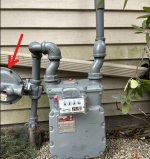

The meter will deliver 583 CFH at a 1" pressure drop.
If you allow for a 1.5" pressure drop, the meter will provide about 740 CFH.
If you allow a 2" pressure drop, the meter will provide 898 CFH.
If they increase the pressure before the meter to 8" w.c to 9" w.c, I think that it will be fine.
In any case verify the pressure at the heater inlet during operation.

So based on what he’s saying in his answer, once we get the 1 1/2” dedicated pipe in, does any tweaking need to be done by gas co. to meter or delivery pressure?
If the pressure starts at 7”, then the pressure at the heater will probably be about 5” w.c to 5.5” w.c.
As long as the pressure to the heater during operation is at least 1” w.c over the minimum, it should be fine.
You can increase the pressure to 8” w.c or 9” w.c to be safe.
I would probably want the initial pressure to be set to about 8.5” w.c.
Verify the pressure under load static and dynamic.
The dynamic should not be more than 1” w.c lower that the static.
As long as the pressure to the heater during operation is at least 1” w.c over the minimum, it should be fine.
You can increase the pressure to 8” w.c or 9” w.c to be safe.
I would probably want the initial pressure to be set to about 8.5” w.c.
Verify the pressure under load static and dynamic.
The dynamic should not be more than 1” w.c lower that the static.
Thread Status
Hello , This thread has been inactive for over 60 days. New postings here are unlikely to be seen or responded to by other members. For better visibility, consider Starting A New Thread.


